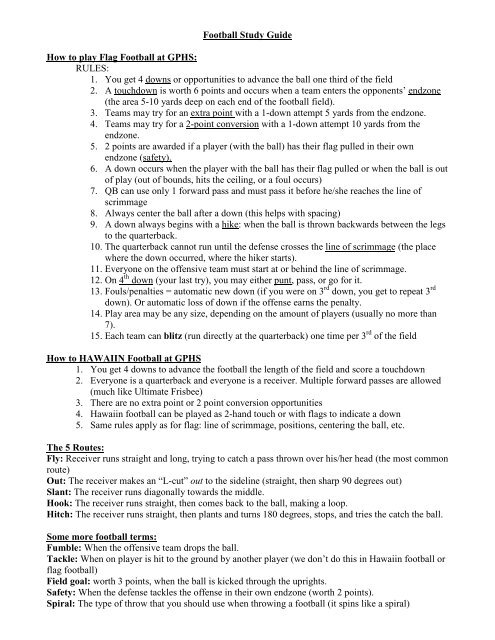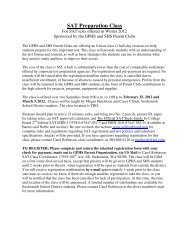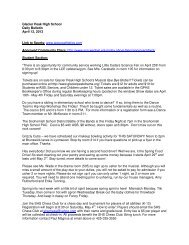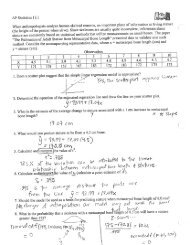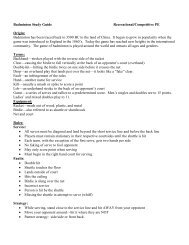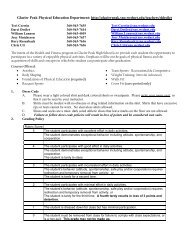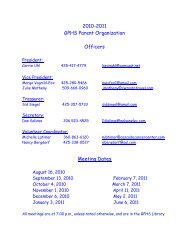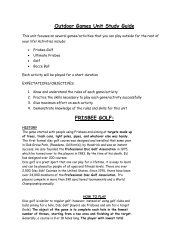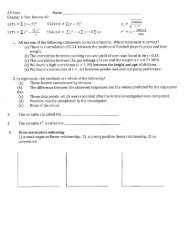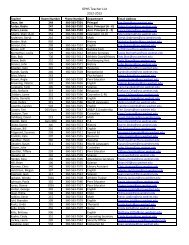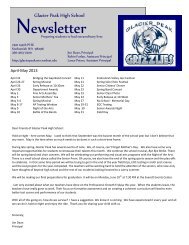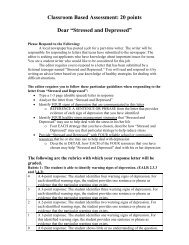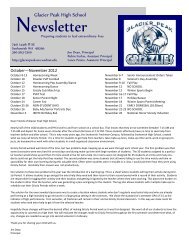Football Study Guide
Football Study Guide
Football Study Guide
Create successful ePaper yourself
Turn your PDF publications into a flip-book with our unique Google optimized e-Paper software.
<strong>Football</strong> <strong>Study</strong> <strong>Guide</strong>How to play Flag <strong>Football</strong> at GPHS:RULES:1. You get 4 downs or opportunities to advance the ball one third of the field2. A touchdown is worth 6 points and occurs when a team enters the opponents’ endzone(the area 5-10 yards deep on each end of the football field).3. Teams may try for an extra point with a 1-down attempt 5 yards from the endzone.4. Teams may try for a 2-point conversion with a 1-down attempt 10 yards from theendzone.5. 2 points are awarded if a player (with the ball) has their flag pulled in their ownendzone (safety).6. A down occurs when the player with the ball has their flag pulled or when the ball is outof play (out of bounds, hits the ceiling, or a foul occurs)7. QB can use only 1 forward pass and must pass it before he/she reaches the line ofscrimmage8. Always center the ball after a down (this helps with spacing)9. A down always begins with a hike: when the ball is thrown backwards between the legsto the quarterback.10. The quarterback cannot run until the defense crosses the line of scrimmage (the placewhere the down occurred, where the hiker starts).11. Everyone on the offensive team must start at or behind the line of scrimmage.12. On 4 th down (your last try), you may either punt, pass, or go for it.13. Fouls/penalties = automatic new down (if you were on 3 rd down, you get to repeat 3 rddown). Or automatic loss of down if the offense earns the penalty.14. Play area may be any size, depending on the amount of players (usually no more than7).15. Each team can blitz (run directly at the quarterback) one time per 3 rd of the fieldHow to HAWAIIN <strong>Football</strong> at GPHS1. You get 4 downs to advance the football the length of the field and score a touchdown2. Everyone is a quarterback and everyone is a receiver. Multiple forward passes are allowed(much like Ultimate Frisbee)3. There are no extra point or 2 point conversion opportunities4. Hawaiin football can be played as 2-hand touch or with flags to indicate a down5. Same rules apply as for flag: line of scrimmage, positions, centering the ball, etc.The 5 Routes:Fly: Receiver runs straight and long, trying to catch a pass thrown over his/her head (the most commonroute)Out: The receiver makes an “L-cut” out to the sideline (straight, then sharp 90 degrees out)Slant: The receiver runs diagonally towards the middle.Hook: The receiver runs straight, then comes back to the ball, making a loop.Hitch: The receiver runs straight, then plants and turns 180 degrees, stops, and tries the catch the ball.Some more football terms:Fumble: When the offensive team drops the ball.Tackle: When on player is hit to the ground by another player (we don’t do this in Hawaiin football orflag football)Field goal: worth 3 points, when the ball is kicked through the uprights.Safety: When the defense tackles the offense in their own endzone (worth 2 points).Spiral: The type of throw that you should use when throwing a football (it spins like a spiral)
Laces: The laced-up part of a football (these should be out when kicking a football)Offsides: When a defensive or offensive player crosses the line of scrimmage before the “snap” orhike.Line of Scrimmage: zone from point to point of the football—offense may not enter this zone,defense may not cross the line until the ball is snappedOfficial Rules and Signals:Offsides: No offensive player other than the center may enter the neutral zone before the ball is hiked.No defensive player may cross the line of scrimmage before the ball is moved.Illegal procedure: No offensive player may be moving towards the ball before it is hiked. Also, no 2offensive players may be moving before the ball is hiked.Delay of Game: The offense has 25 seconds to call their play and hike the ball.Clipping: No offensive player may block or push a defensive player from the back.Holding: No offensive player may contact another player when the ball is in the air, either on offenseor defense.Pass Interference: No player may contact another player when the ball is in the air, either on offenseor defense.Incomplete pass: The ball when thrown must be caught or the offense loses the down and the line ofscrimmage goes back to where it was on the previous play.Touchdown or field goal: These occur when the ball crosses the goal line or is kicked through thegoal posts.Ineligible receiver downfield: This occurs when a player other than a back or an end is more than 3yards downfield on a pass play.Roughing the kicker: No player may make contact with a kicker or punter after the ball has beenkicked without making contact with the ball first.Positions:Quarterback: throws the ball, sets up runsWide Receiver: receives the passCorner Back: defensive player who guards receiversCenter: hikes the ball to the QB-lines up in front of him/herLinebackers: defensive backs—guard linemanSafety: defender—lines up in the backfield—last line of defense**If you want to look up further signals or download pictures, check out www.<strong>Football</strong>.com andgo to Basic Rules.Be responsible for knowing the warm up that we practiceevery day, as well as how to perform all of the routes andskills involved in that warm up!


